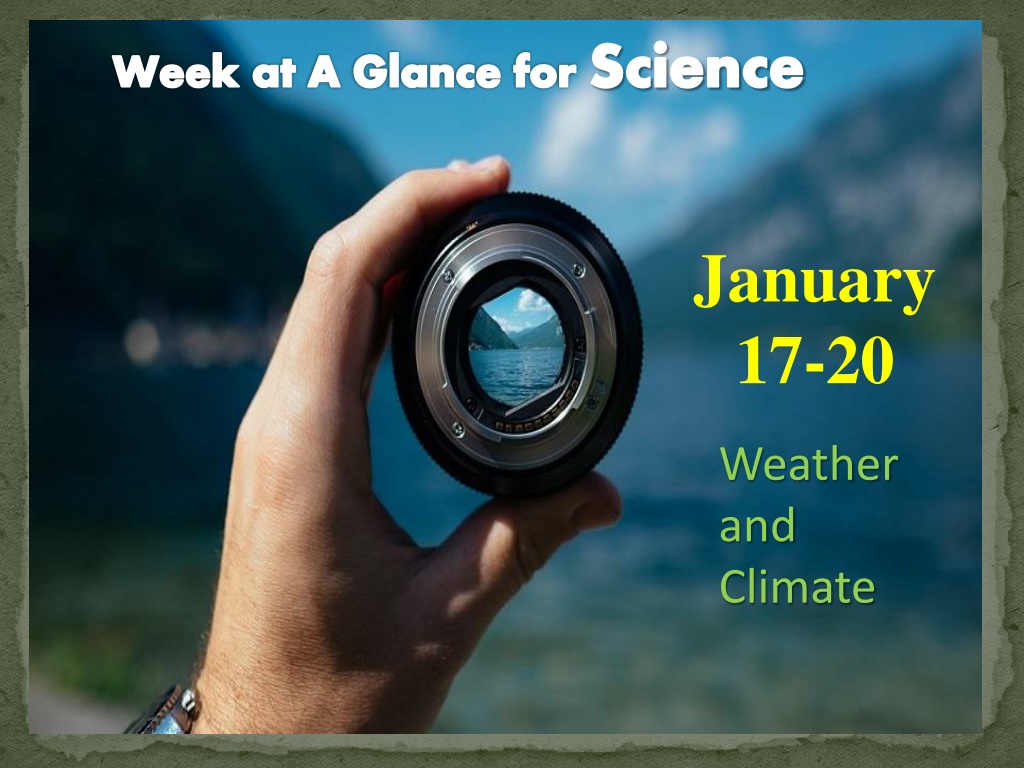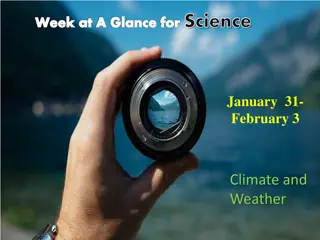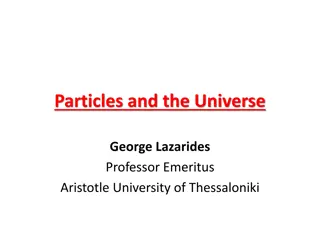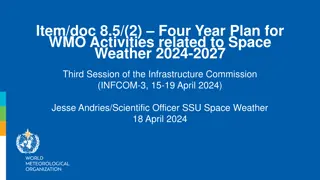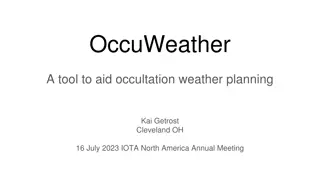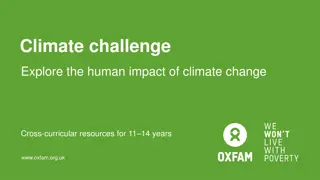Understanding Climate and Weather Interactions in Science
Explore the impact of the sun, land, and water on climate and weather patterns through investigations and models. Learn about energy transfer processes, atmospheric composition, and weather phenomena like tornadoes and hurricanes. Gain insights into how unequal heating and Earth's rotation influence wind systems and meteorological events.
Download Presentation
Please find below an Image/Link to download the presentation.
The content on the website is provided AS IS for your information and personal use only. It may not be sold, licensed, or shared on other websites without obtaining consent from the author. Download presentation by click this link. If you encounter any issues during the download, it is possible that the publisher has removed the file from their server.
Presentation Transcript
Week at A Glance for Science January 17-20 Weather and Climate
S6E4. Obtain, evaluate, and communicate information about how the sun, land, and water affect climate and weather. c. Develop a model demonstrating the interaction between unequal heating and the rotation of the Earth that causes local and global wind systems. d. Construct an explanation of the relationship between air pressure, weather fronts, and air masses and meteorological events such as tornados and thunderstorms.
S6E4. Obtain, evaluate, and communicate information about how the sun, land, and water affect climate and weather. a. Analyze and interpret data to compare and contrast the composition of Earth s atmospheric layers (including the ozone layer) and greenhouse gases. (Clarification statement: Earth s atmospheric layers include the troposphere, stratosphere, mesosphere, and thermosphere.) b. Plan and carry out an investigation to demonstrate how energy from the sun transfers heat to air, land and water at different rates. (Clarification statement: Heat transfer should include the processes of conduction, convection, and radiation.) c. Develop a model demonstrating the interaction between unequal heating and the rotation of the Earth that causes local and global wind systems. d. Construct an explanation of the relationship between air pressure, weather fronts, and air masses and meteorological events such as tornados and thunderstorms. e. Analyze and interpret weather data to explain the effects of moisture evaporating from the ocean on weather patterns and weather events such as hurricanes.
Plan and carry out an investigation to demonstrate how energy from the sun transfers heat to air, land and water at different rates. (Clarification statement: Heat transfer should include the processes of conduction, convection, and radiation.)
S6E4. Obtain, evaluate, and communicate information about how the sun, land, and water affect climate and weather. B Plan and carry out an investigation to demonstrate how energy from the sun transfers heat to air, land and water at different rates. (Clarification statement: Heat transfer should include the processes of conduction, convection, and radiation.) C Develop a model demonstrating the interaction between unequal heating and the rotation of the Earth that causes local and global wind systems.
radiation is the emission or transmission of energy in the form of waves or particles through space or through a material medium. Conduction is the process by which heat is transferred from the hotter end to the colder end of an object. The ability of the object to conduct heat is known as its thermal conductivity, and is denoted k. Convection the movement caused within a fluid by the tendency of hotter and therefore less dense material to rise, and colder, denser material to sink under the influence of gravity, which consequently results in transfer of heat.
Video link: Conduction, Convection, Radiation Video Link; Heat Transfer
Homework for Science Monday: Tuesday: Wednesday: Thursday:
Tuesday, January 18 Standard: S6E4. c) Develop a model demonstrating the interaction between unequal heating and the rotation of the Earth that causes local and global wind systems. Learning Target: I can explain how unequal heating and Earth s rotation causes local and global wind systems. Warm-up: Chapter 11 Workbook Packet Work Session: Unit: 3 Weather and Climate; TB Wind Systems; Review for Quiz Science Fair Project Closing: Think Pair Share Reminders: Quiz on Wednesday
Wednesday, January 18 Standard: S6E4.d Construct an explanation of the relationship between air pressure, weather fronts, and air masses and meteorological events such as tornados and thunderstorms. Learning Target: I can explain how the suns energy heats earth causing air pressure, air masses, and weather fronts that causes major weather events. Warm-up: Chapter 11 Workbook Packet Work Session: Unit: 3 Weather and Climate; TB Wind Systems, weather fronts, air masses; Quiz Science Fair Project Closing: TOD Reminders: Quiz
Thursday, January 19 Standard: S6E4.d Construct an explanation of the relationship between air pressure, weather fronts, and air masses and meteorological events such as tornados and thunderstorms. Learning Target: I can explain how the suns energy heats earth causing air pressure, air masses, and weather fronts that causes major weather events. Warm-up: Chapter 11 Workbook Packet Work Session: Unit: 3 Weather and Climate; TB Weather fronts and air masses; Quiz Science Fair Project Closing: Student Summarize Reminders:
Friday, January 20 Standard: S6E4.d Construct an explanation of the relationship between air pressure, weather fronts, and air masses and meteorological events such as tornados and thunderstorms. Learning Target: I can explain how the suns energy heats earth causing air pressure, air masses, and weather fronts that causes major weather events. Warm-up: Chapter 13 Workbook Packet Work Session: Unit: 3 Weather and Climate; TB Tornadoes and Thunderstorms; Stations Science Fair Project Closing: Think Pair Share Reminders: Quiz
Science Fair Project Video Link to How to do a Science Fair Project
